Development and Field Validation of Low-Cost Metal Oxide Nanosensors for Tropospheric Ozone Monitoring in Rural Areas
Abstract
1. Introduction
2. Materials and Methods
2.1. Metal Oxide Gas Sensors
2.1.1. Commercial Sensors
2.1.2. Nanostructured Sensors
2.2. Air Pollution Monitoring Devices
2.2.1. Device Design
2.2.2. Laboratory Measurements
2.3. Field Campaign
2.3.1. Monfragüe National Park
2.3.2. Sensor Calibration
2.3.3. Data Uncertainty
3. Results and Discussion
3.1. Sensor Calibration
3.2. Data Uncertainty
4. Conclusions
Author Contributions
Funding
Institutional Review Board Statement
Informed Consent Statement
Acknowledgments
Conflicts of Interest
References
- Warneck, P. Ozone in the trophosphere. In Chemistry of the Natural Atmosphere; Academic Press Inc.: London, UK, 1988; Volume 41, pp. 176–222. [Google Scholar]
- Agrawal, S.B.; Agrawal, M.; Singh, A. Tropospheric Ozone: A Hazard for Vegetation and Human Health; Cambridge Scholars Publishing: Newcastle upon Tyne, UK, 2021. [Google Scholar]
- Ryffel, B.; Hamacher, J.; Manoussa Ethel Fanny, S.; Erard, F.; Zhang, J.; Wei, Y.; Fang, Z. Ozone Pollution: A Major Health Hazard Worldwide. Front. Immunol. 2019, 10, 2518. [Google Scholar] [CrossRef]
- World Health Organization (WHO). Health Risks of Ozone from Long-Range Transboundary Air Pollution; WHO Regional Office for Europe: Geneva, Switzerland, 2008; ISBN 9789289042895. [Google Scholar]
- Nuvolone, D.; Petri, D.; Voller, F. The effects of ozone on human health. Environ. Sci. Pollut. Res. 2017, 25, 8074–8088. [Google Scholar] [CrossRef]
- Malley, C.S.; Henze, D.K.; Kuylenstierna, J.C.I.; Vallack, H.W.; Davila, Y.; Anenberg, S.C.; Turner, M.C.; Ashmore, M.R. Updated Global Estimates of Respiratory Mortality in Adults ≥30 Years of Age Attributable to Long-Term Ozone Exposure. Environ. Health Perspect. 2017, 125, 87021. [Google Scholar] [CrossRef]
- Grulke, N.E.; Heath, R.L. Ozone effects on plants in natural ecosystems. Plant Biol. 2019, 22, 12–37. [Google Scholar] [CrossRef]
- Emberson, L. Effects of ozone on agriculture, forests and grasslands. Philos. Trans. A Math. Phys. Eng. Sci. 2020, 378, 20190327. [Google Scholar] [CrossRef]
- Jakovljević, T.; Lovreškov, L.; Jelić, G.; Anav, A.; Popa, I.; Fornasier, M.F.; Proietti, C.; Limić, I.; Butorac, L.; Vitale, M.; et al. Impact of ground-level ozone on Mediterranean forest ecosystems health. Sci. Total Environ. 2021, 783, 147063. [Google Scholar] [CrossRef]
- Wang, Y.; Wild, O.; Ashworth, K.; Chen, X.; Wu, Q.; Qi, Y.; Wang, Z. Reductions in crop yields across China from elevated ozone. Environ. Pollut. 2022, 292, 118218. [Google Scholar] [CrossRef]
- Sharps, K.; Hayes, F.; Harmens, H.; Mills, G. Ozone-induced effects on leaves in African crop species. Environ. Pollut. 2021, 268, 115789. [Google Scholar] [CrossRef]
- Dolker, T.; Agrawal, M. Negative impacts of elevated ozone on dominant species of semi-natural grassland vegetation in Indo-Gangetic plain. Ecotoxicol. Environ. Saf. 2019, 182, 109404. [Google Scholar] [CrossRef]
- Ainsworth, E.A.; Yendrek, C.R.; Sitch, S.; Collins, W.J.; Emberson, L.D. The Effects of Tropospheric Ozone on Net Primary Productivity and Implications for Climate Change. Annu. Rev. Plant Biol. 2012, 63, 637–661. [Google Scholar] [CrossRef]
- Shindell, D.; Faluvegi, G.; Lacis, A.; Hansen, J.; Ruedy, R.; Aguilar, E. Role of tropospheric ozone increases in 20th-century climate change. J. Geophys. Res. 2006, 111, D08302. [Google Scholar] [CrossRef]
- World Health Organization. WHO Global Air Quality Guidelines: Particulate Matter (PM2.5 and PM10), Ozone, Nitrogen Dioxide, Sulfur Dioxide and Carbon Monoxide; WHO: Geneva, Switzerland, 2021; ISBN 978-92-4-003422-8. [Google Scholar]
- Karpus, K. Implementation of directive 2008/50/EC of 21 May 2008 on Ambient Air Quality and Cleaner Air for Europe in Polish environmental law. Polish Yearb. Environ. Law 2012, 2, 63–82. [Google Scholar] [CrossRef][Green Version]
- Cooper, O.R.; Parrish, D.D.; Ziemke, J.; Balashov, N.V.; Cupeiro, M.; Galbally, I.E.; Gilge, S.; Horowitz, L.; Jensen, N.R.; Lamarque, J.-F.; et al. Global distribution and trends of tropospheric ozone: An observation-based review. Elem. Sci. Anthr. 2014, 2, 000029. [Google Scholar] [CrossRef]
- Proietti, C.; Fornasier, M.F.; Sicard, P.; Anav, A.; Paoletti, E.; De Marco, A. Trends in tropospheric ozone concentrations and forest impact metrics in Europe over the time period 2000–2014. J. For. Res. 2020, 32, 543–551. [Google Scholar] [CrossRef]
- European Environmental Agency (EEA). Air Quality in Europe—2020 Report; EEA Report No 9/2020; Publications Office of the European Union: Luxembourg, 2020. [Google Scholar] [CrossRef]
- Viana, M.; Padrosa, M.; Querol, X.; Alastuey, A.; Benesova, N.; Krejčí, B.; Volná, V.; Real, E.; Colette, A.; de Leeuw, F.; et al. Ozone in Southern Europe—Assessment and Effectiveness of Measures. European Tropic Center on Air Pollution and Climate Change Mitigation (ETC/ACM), Technical Paper 2017/3. 2017. Available online: http://www.eionet.europa.eu (accessed on 11 November 2022).
- Querol, X.; Alastuey, A.; Pandolfi, M.; Reche, C.; Pérez, N.; Minguillón, M.C.; Moreno, T.; Viana, M.; Escudero, M.; Orio, A.; et al. 2001–2012 trends on air quality in Spain. Sci. Total Environ. 2014, 490, 957–969. [Google Scholar] [CrossRef]
- García, M.Á.; Villanueva, J.; Pardo, N.; Pérez, I.A.; Sánchez, M.L. Analysis of ozone concentrations between 2002–2020 in urban air in Northern Spain. Atmosphere 2021, 12, 1495. [Google Scholar] [CrossRef]
- Adame, J.A.; Gutiérrez-Álvarez, I.; Cristofanelli, P.; Notario, A.; Bogeat, J.A.; López, A.; Gómez, A.; Bolívar, J.P.; Yela, M. Surface ozone trends over a 21-year period at El Arenosillo observatory (Southwestern Europe). Atmos. Res. 2022, 269, 106048. [Google Scholar] [CrossRef]
- Pay, M.T.; Gangoiti, G.; Guevara, M.; Napelenok, S.; Querol, X.; Jorba, O.; García-Pando, C.P. Ozone source apportionment during peak summer events over southwestern Europe. Atmos. Chem. Phys. 2019, 19, 5467–5494. [Google Scholar] [CrossRef]
- Cristofanelli, P.; Bonasoni, P. Background ozone in the southern Europe and Mediterranean area: Influence of the transport processes. Environ. Pollut. 2009, 157, 1399–1406. [Google Scholar] [CrossRef]
- Maiheu, B.; Janssen, B. Assessing the Spatial Representativeness of Air Quality Sampling Points—Literature Review; Ricardo, N.B.V., Ed.; Report for European Commission—DG Environment, Ricardo/ED11492; Ricardo Nederland B.V.: Utrecht, The Netherlands, 2019. [Google Scholar]
- Galán-Madruga, D. Chapter 3: Importance of Air Quality Networks in Controlling Exposure to Air Pollution. In Environmental Emissions; IntechOpen Ltd.: London, UK, 2021. [Google Scholar] [CrossRef]
- Castell, N.; Dauge, F.R.; Schneider, P.; Vogt, M.; Lerner, U.; Fishbain, B.; Broday, D.; Bartonova, A. Can commercial low-cost sensor platforms contribute to air quality monitoring and exposure estimates? Environ. Int. 2017, 99, 293–302. [Google Scholar]
- Liu, X.; Jayaratne, R.; Thai, P.; Kuhn, T.; Zing, I.; Christensen, B.; Lamont, R.; Dunbabin, M.; Zhu, S.; Gao, J.; et al. Low-cost sensors as an alternative for long-term air quality monitoring. Environ. Res. 2020, 185, 109438. [Google Scholar] [CrossRef]
- Karagulian, F.; Barbiere, M.; Kotsev, A.; Spinelle, L.; Gerboles, M.; Lagler, F.; Redon, N.; Crunaire, S.; Borowiak, A. Review of the Performance of Low-Cost Sensors for Air Quality Monitoring. Atmosphere 2019, 10, 506. [Google Scholar] [CrossRef]
- Majid, M.; Habik, S.; Javed, A.R.; Rizwan, M.; Srivastava, G.; Gadekallu, T.R.; Lin, J.C.-W. Applications of Wireless Sensor Networks and Internet of Things Frameworks in the Industry Revolution 4.0: A Systematic Literature Review. Sensors 2022, 22, 2087. [Google Scholar] [CrossRef]
- Clements, A.L.; Griswold, W.G.; Abhijit, R.S.; Johnston, J.E.; Herting, M.M.; Thorson, J.; Collier-Oxandale, A.; Hannigan, M. Low-Cost Air Quality Monitoring Tools: From Research to Practice (A Workshop Summary). Sensors 2017, 17, 2478. [Google Scholar] [CrossRef]
- Williams, D.E. Low Cost Sensor Networks: How Do We Know the Data Are Reliable? ACS Sens. 2019, 4, 2558–2565. [Google Scholar] [CrossRef]
- Lewis, A.; Edwards, P. Validate personal air-pollution sensors. Nature 2016, 535, 29–31. [Google Scholar] [CrossRef]
- Nikolic, M.V.; Milovanovic, V.; Vasiljevic, Z.Z.; Stamenkovic, Z. Semiconductor Gas Sensors: Materials, Technology, Design, and Application. Sensors 2020, 20, 6694. [Google Scholar] [CrossRef]
- Narayana, M.V.; Jalihal, D.; Shiva Nagendra, S.M. Establishing A Sustainable Low-Cost Air Quality Monitoring Setup: A Survey of the State-of-the-Art. Sensors 2022, 22, 394. [Google Scholar] [CrossRef]
- Gomes, J.B.A.; Rodrigues, J.J.P.C.; Rabêlo, R.A.L.; Kumar, N.; Kozlov, S. IoT-Enabled Gas Sensors: Technologies, Applications, and Opportunities. J. Sens. Actuator Netw. 2019, 8, 57. [Google Scholar] [CrossRef]
- Rüffer, D.; Hoehne, F.; Bühler, J. New Digital Metal-Oxide (MOx) Sensor Platform. Sensors 2018, 18, 1052. [Google Scholar] [CrossRef]
- Ji, H.; Zeng, W.; Li, Y. Gas sensing mechanisms of metal oxide semiconductors: A focus review. Nanoscale 2019, 11, 22664–22684. [Google Scholar] [CrossRef]
- Kamarudin, K.; Bennetts, V.H.; Mamduh, S.M.; Visvanathan, R.; Yeon, A.S.A.; Shakaff, A.Y.M.; Zakaria, A.; Abdullah, A.H.; Kamarudin, L.M. Cross-sensitivity of metal oxide gas sensor to ambient temperature and humidity: Effects on gas distribution mapping. AIP Conf. Proc. 2017, 1808, 020025. [Google Scholar]
- Wang, C.; Yin, L.; Zhang, L.; Xiang, D.; Gao, R. Metal Oxide Gas Sensors: Sensitivity and Influencing Factors. Sensors 2010, 10, 2088–2106. [Google Scholar] [CrossRef]
- Isaac, N.A.; Pikaar, I.; Biskos, G. Metal oxide semiconducting nanomaterials for air quality gas sensors: Operating principles, performance, and synthesis techniques. Microchim. Acta 2022, 189, 196. [Google Scholar] [CrossRef]
- Liu, J.; Zhang, L.; Fan, J.; Yu, J. Semiconductor Gas Sensor for Triethylamine Detection. Small 2022, 18, 2104984. [Google Scholar] [CrossRef]
- Xue, S.; Cao, S.; Huang, Z.; Yang, D.; Zhang, G. Improving Gas-Sensing Performance Based on MOS Nanomaterials: A Review. Materials 2021, 14, 4263. [Google Scholar] [CrossRef]
- Fazio, E.; Spadaro, S.; Corsaro, C.; Neri, G.; Leonardi, S.G.; Neri, F.; Lavanya, N.; Sekar, C.; Donato, N.; Neri, G. Metal-Oxide Based Nanomaterials: Synthesis, Characterization and their Applications in Electrical and Electrochemical Sensors. Sensors 2021, 21, 2494. [Google Scholar] [CrossRef]
- Li, Z.; Li, H.; Wu, Z.; Wang, M.; Luo, J.; Torun, H.; Hu, P.; Yang, C.; Grundmann, M.; Liu, X.; et al. Advances in designs and mechanisms of semiconducting metal oxide nanostructures for high-precision gas sensors operated at room temperature. Mater. Horizons 2019, 6, 470–506. [Google Scholar] [CrossRef]
- Rickerby, D.G.; Skouloudis, A.N. Chapter 21: Nanostructured Metal Oxides for Sensing Toxic Air Pollutants. In Advanced Environmental Analysis: Applications of Nanomaterials; Book Series: Detection Science; Royal Society of Chemistry Publishing: Cambridge, UK, 2017; Volume 2, pp. 48–90. [Google Scholar] [CrossRef]
- Masuda, Y. Recent advances in SnO2 nanostructure based gas sensors. Sens. Actuators B Chem. 2022, 364, 131876. [Google Scholar] [CrossRef]
- Que, M.; Lin, C.; Sun, J.; Chen, L.; Sun, X.; Sun, Y. Progress in ZnO Nanosensors. Sensors 2021, 21, 5502. [Google Scholar] [CrossRef]
- Yi, W.Y.; Lo, K.M.; Mak, T.; Leung, K.S.; Leung, Y.; Meng, M.L. A Survey of Wireless Sensor Network Based Air Pollution Monitoring Systems. Sensors 2015, 15, 31392–31427. [Google Scholar] [CrossRef]
- Ando, M.; Biju, V.; Shigeri, Y. Development of Technologies for Sensing Ozone in Ambient Air. Anal. Sci. 2018, 34, 263–271. [Google Scholar] [CrossRef]
- Sironi, S.; Capelli, L.; Spinelle, L.; Gerboles, M.; Aleixandre, M.; Bonavitacola, F. Evaluation of Metal Oxides Sensors for the Monitoring of O3 in Ambient Air at Ppb Level. Chem. Eng. Trans. 2016, 54, 319–324. [Google Scholar] [CrossRef]
- Spinelle, L.; Gerboles, M.; Villani, M.G.; Aleixandre, M.; Bonavitacola, F. Field calibration of a cluster of low-cost available sensors for air quality monitoring. Part A: Ozone and nitrogen dioxide. Sens. Actuators B Chem. 2015, 215, 249–257. [Google Scholar] [CrossRef]
- Williams, D.E.; Henshaw, G.S.; Bart, M.; Laing, G.; Wagner, J.; Naisbitt, S.; Salmond, J.A. Validation of low-cost ozone measurement instruments suitable for use in an air-quality monitoring network. Meas. Sci. Technol. 2013, 24, 65803. [Google Scholar] [CrossRef]
- Peterson, P.J.D.; Aujla, A.; Grant, K.H.; Brundle, A.G.; Thompson, M.R.; Vande Hey, J.; Leigh, R.J. Practical Use of Metal Oxide Semiconductor Gas Sensors for Measuring Nitrogen Dioxide and Ozone in Urban Environments. Sensors 2017, 17, 1653. [Google Scholar] [CrossRef]
- Gautam, Y.K.; Sharma, K.; Tyagi, S.; Ambedkar, A.K.; Chaudhary, M.; Singh, B.P. Nanostructured metal oxide semiconductor-based sensors for greenhouse gas detection: Progress and challenges. R. Soc. Open Sci. 2022, 8, 201324. [Google Scholar] [CrossRef]
- Sales-Lérida, D.; Bello, A.J.; Sánchez-Alzola, A.; Martínez-Jiménez, P.M. An Approximation for Metal-Oxide Sensor Calibration for Air Quality Monitoring Using Multivariable Statistical Analysis. Sensors 2021, 21, 4781. [Google Scholar] [CrossRef]
- Spinelle, L.; Gerboles, M.; Villani, M.G.; Aleixandre, M.; Bonavitacola, F. Field calibration of a cluster of low-cost commercially available sensors for air quality monitoring. Part B: NO, CO and CO2. Sens. Actuators B Chem. 2017, 238, 706–715. [Google Scholar] [CrossRef]
- Yoboué, P.; Konaté, A.; Asseu, O.; Ménini, P. An industrializable silicon-based microhotplate for metal oxides gas sensors. Phys. Chem. News 2014, 72, 34–41. [Google Scholar]
- Dufour, N.; Chapelle, A.; Mesnilgrente, F.; Conedera, V.; Menini, P. Technological Improvements of a Metal Oxide Gas Multi- Sensor Based on a Micro-Hotplate Structure and Inkjet Deposition for an Automotive Air Quality Sensor Application. In Proceedings of the 25th Micromechanics and Microsystems Europe workshop (MME 2014), Istambul, Turkey, 31 August 2014. [Google Scholar]
- Presmanes, L.; Thimont, Y.; El Younsi, I.; Chapelle, A.; Blanc, F.; Talhi, C.; Bonningue, C.; Barnabé, A.; Menini, P.; Tailhades, P. Integration of P-CuO Thin Sputtered Layers onto Microsensor Platforms for Gas Sensing. Sensors 2017, 17, 1409. [Google Scholar] [CrossRef]
- Presmanes, L.; Gunasekaran, V.; Thimont, Y.; Sinnarasa, I.; Barnabe, A.; Menini, P.; Tailhades, P. Ga doped ZnO thin films deposited by RF sputtering for NO2 sensing. In Proceedings of the 2019 5th Experiment International Conference (exp.at’19), Funchal, Portugal, 12–14 June 2019. [Google Scholar] [CrossRef]
- Masa, S.; Hontañón, E.; Santos, J.P.; Sayago, I.; Lozano, J. Chemiresistive sensors based on electrospun tin oxide nanofibers for detecting NO2 at the sub-0.1 ppm level. In Proceedings of the 2019 5th Experiment International Conference (exp.at’19), Funchal, Portugal, 12–14 June 2019. [Google Scholar] [CrossRef]
- Masa, S.; Robés, D.; Hontañón, E.; Lozano, J.; Eqtesadi, S.; Narros, A. Graphene-Tin Oxide Composite Nanofibers for Low Temperature Detection of NO2 and O3. Sens. Transducers 2020, 246, 71–78. [Google Scholar]
- Ministerio para la Transición Ecológica y el Reto Demográfico (MITECO). Evaluación de la Calidad del Aire en España 2021; Ministerio para la Transición Ecológica y el Reto Demográfico: Madrid, Spain, 2022. [Google Scholar]
- Cerrato-Alvarez, M.; Núñez-Corchero, M.; Miró-Rodríguez, C.; Pinilla-Gil, E. Synoptic circulation patterns and local sources associated to high concentrations of tropospheric ozone in rural and suburban areas in southwestern Spain. Air Qual. Atmos. Health 2020, 13, 97–108. [Google Scholar] [CrossRef]
- Escudero, M.; Lozano, A.; Hierro, J.; Tapia, O.; del Valle, J.; Alastuey, A.; Moreno, T.; Anzano, J.; Querol, X. Assessment of the variability of atmospheric pollution in National Parks of mainland Spain. Atmos. Environ. 2016, 132, 332–344. [Google Scholar] [CrossRef]
- Kim, S.; Sung, H.; Kim, S.; Je, M.; Kim, J.H. ML-based humidity and temperature calibration system for heterogeneous mox sensor array in ppm-level BTEX monitoring. In Proceedings of the 2021 IEEE International Symposium on Circuits and Systems (ISCAS), Daegu, Korea, 22–28 May 2021. [Google Scholar] [CrossRef]
- EC Working Group. Guidance to the Demonstration of Equivalence of Ambient Air Monitoring Methods Report by an EC Working Group on Guidance for the Demonstration of Equivalence. 2010. Available online: https://scholar.google.com.hk/scholar?cluster=9783433903127910149&hl=zh-TW&as_sdt=2005&sciodt=0,5 (accessed on 28 September 2022).
- Djedidi, O.; Djeziri, M.A.; Morati, N.; Seguin, J.-L.; Bendahan, M.; Contaret, T. Accurate detection and discrimination of pollutant gases using a temperature modulated MOX sensor combined with feature extraction and support vector classification. Sensors Actuators B Chem. 2021, 339, 129817. [Google Scholar] [CrossRef]
- Bruno, C.; Licciardello, A.; Nastasi, G.A.M.; Passaniti, F.; Brigante, C.; Sudano, F.; Faulisi, A.; Alessi, E. Embedded Artificial Intelligence Approach for Gas Recognition in Smart Agriculture Applications Using Low Cost MOX Gas Sensors. In Proceedings of the 2021 Smart Systems Integration (SSI), Grenoble, France, 27–29 April 2021; pp. 9–13. [Google Scholar] [CrossRef]
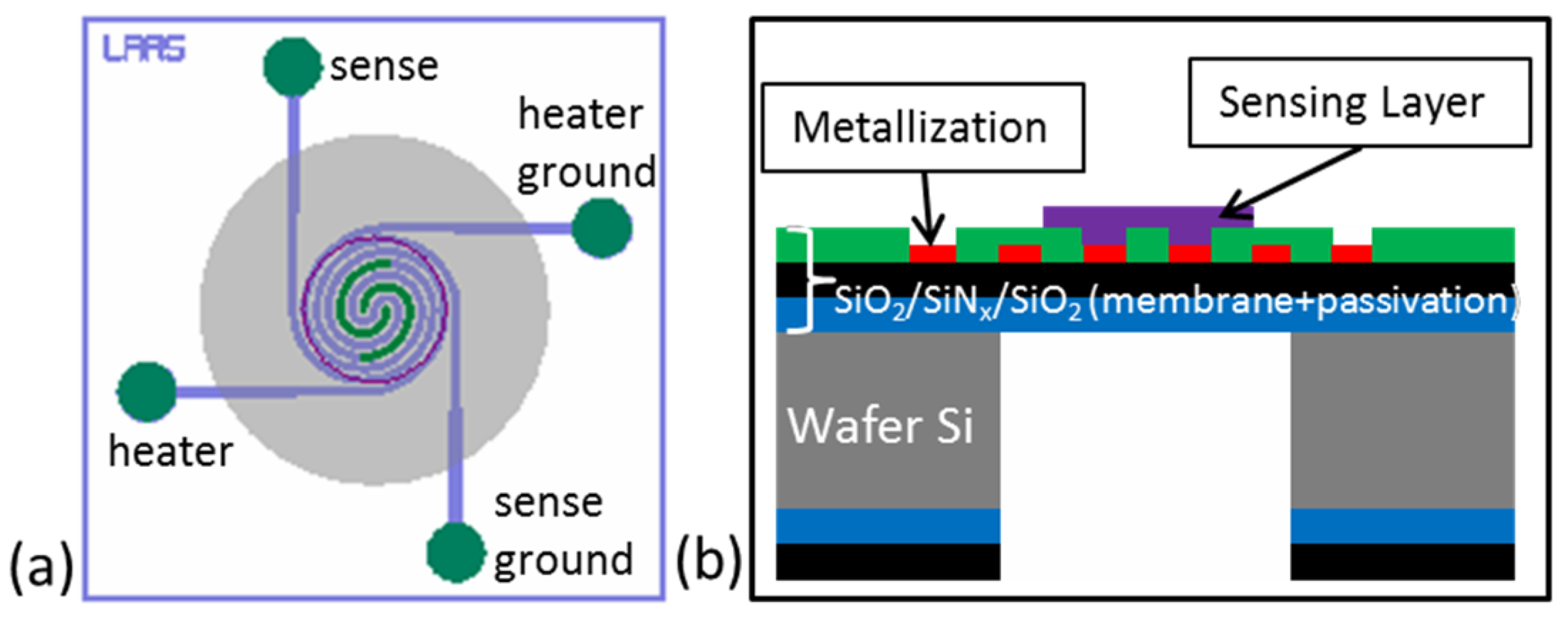


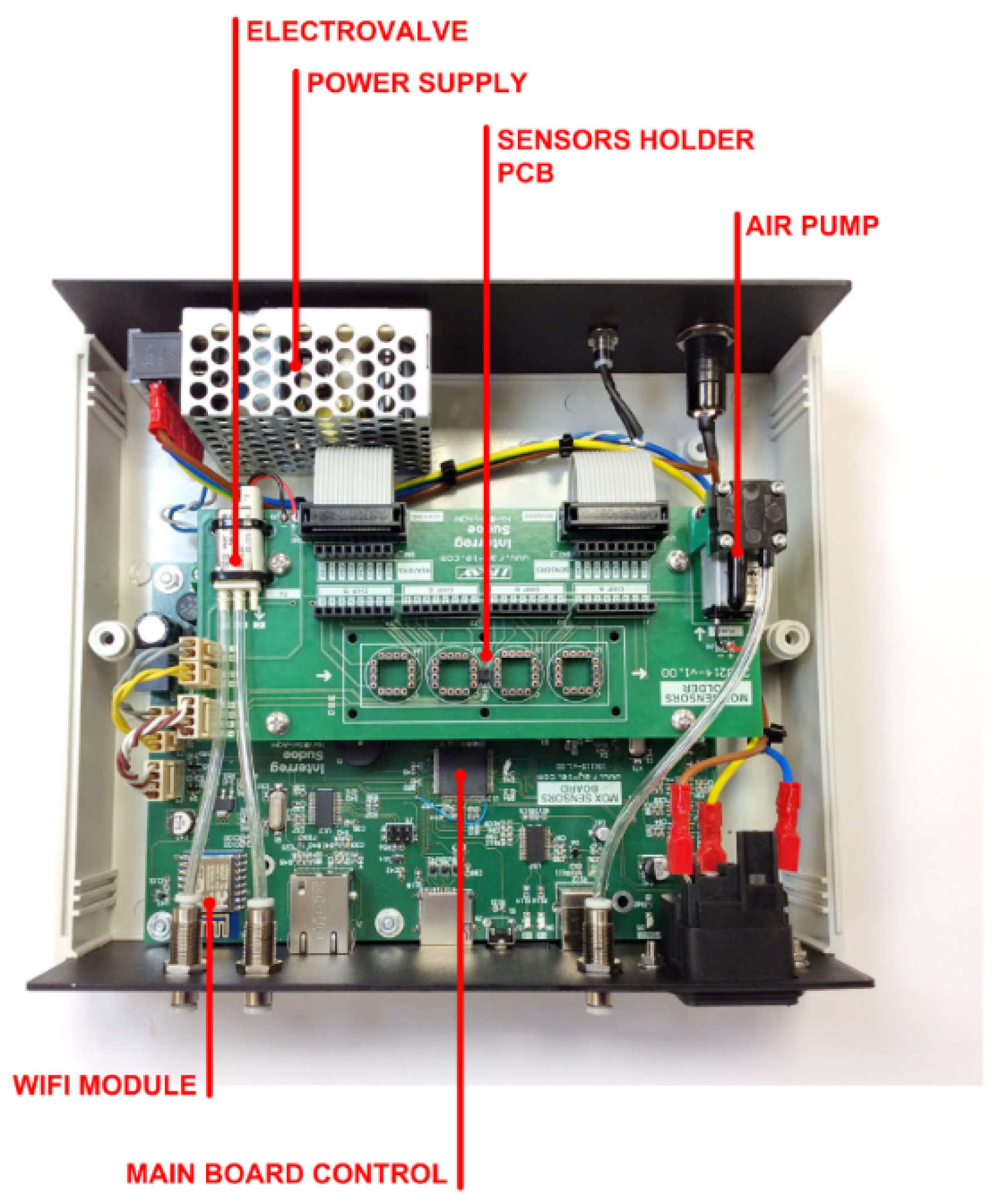

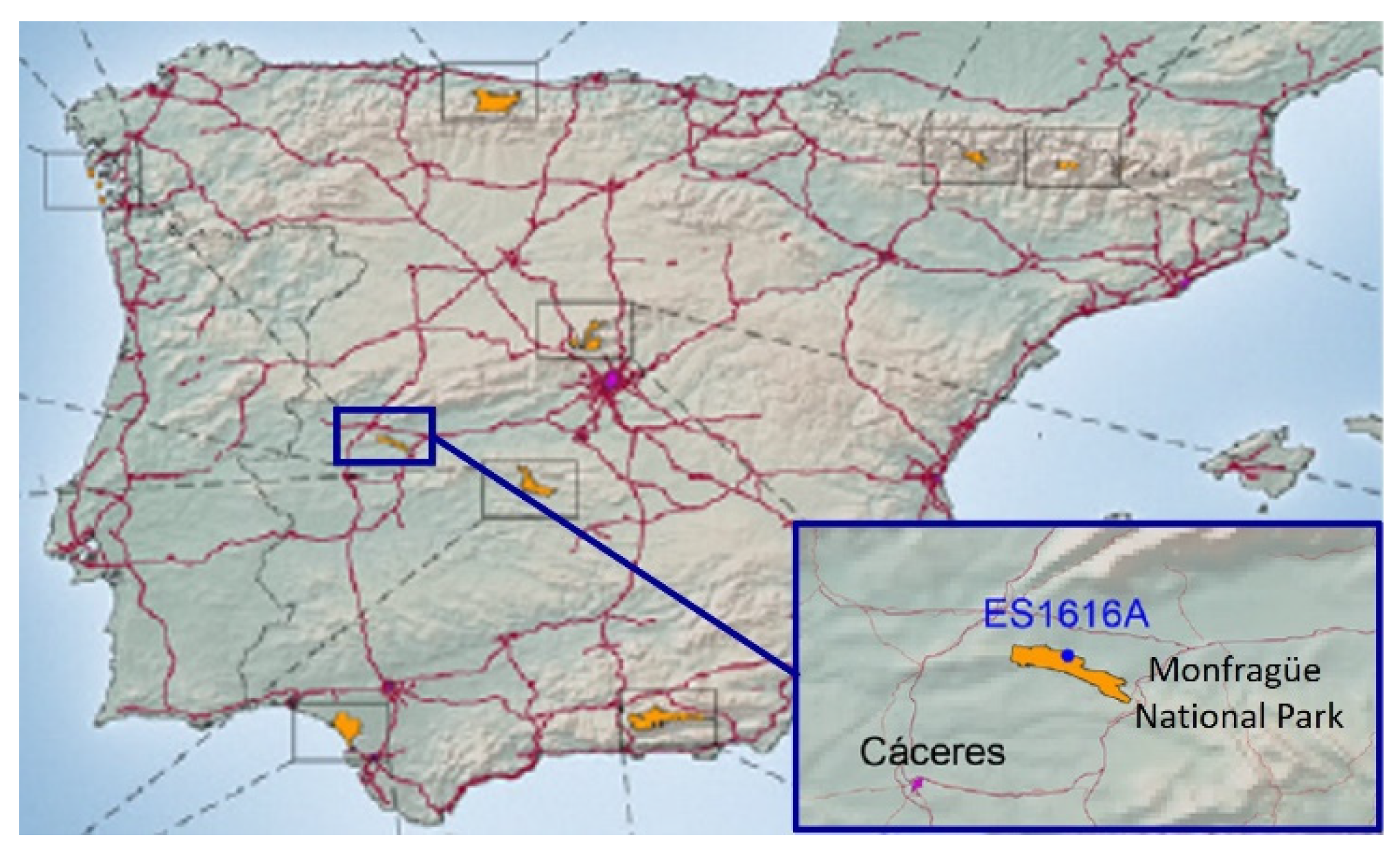
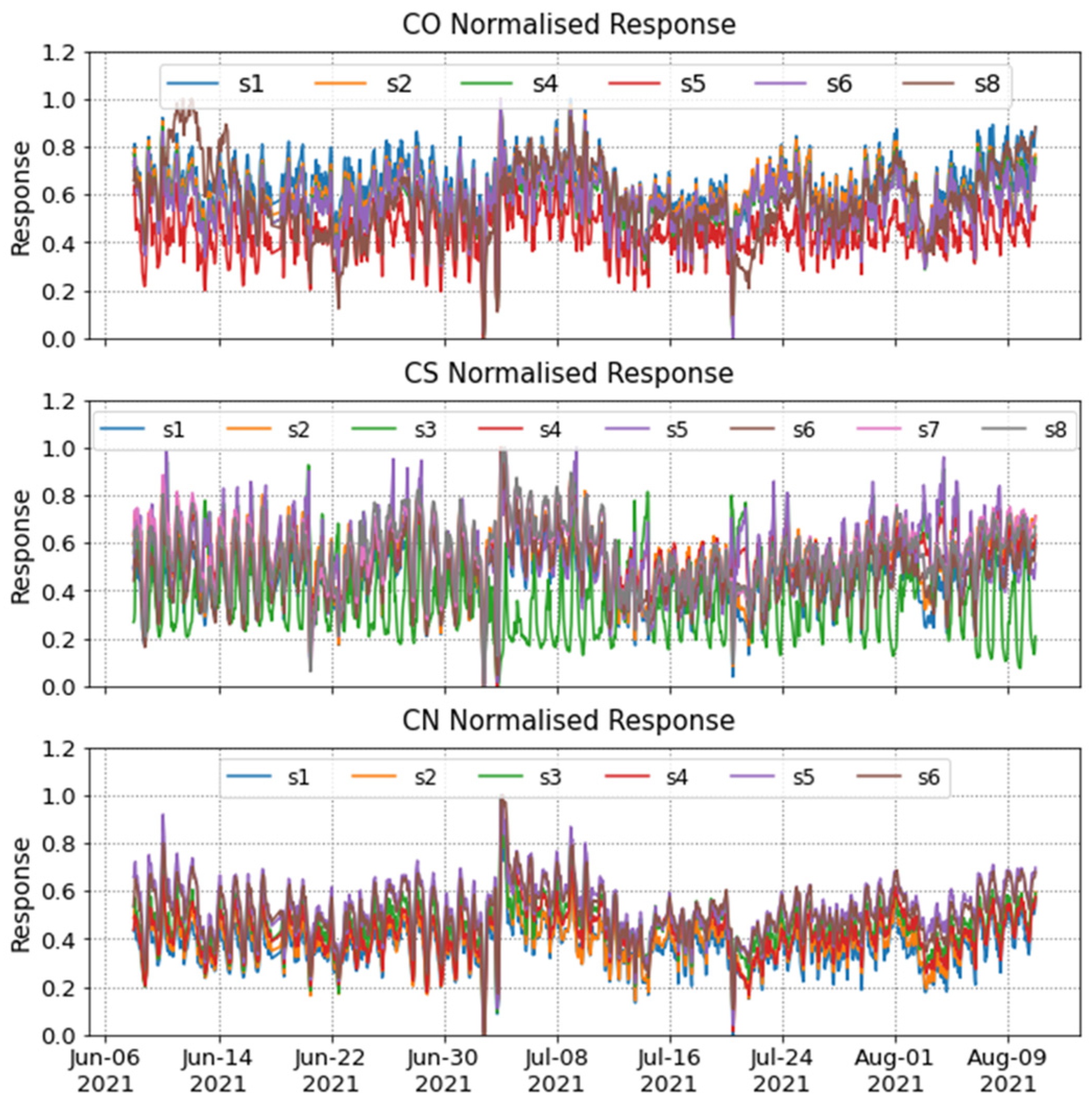
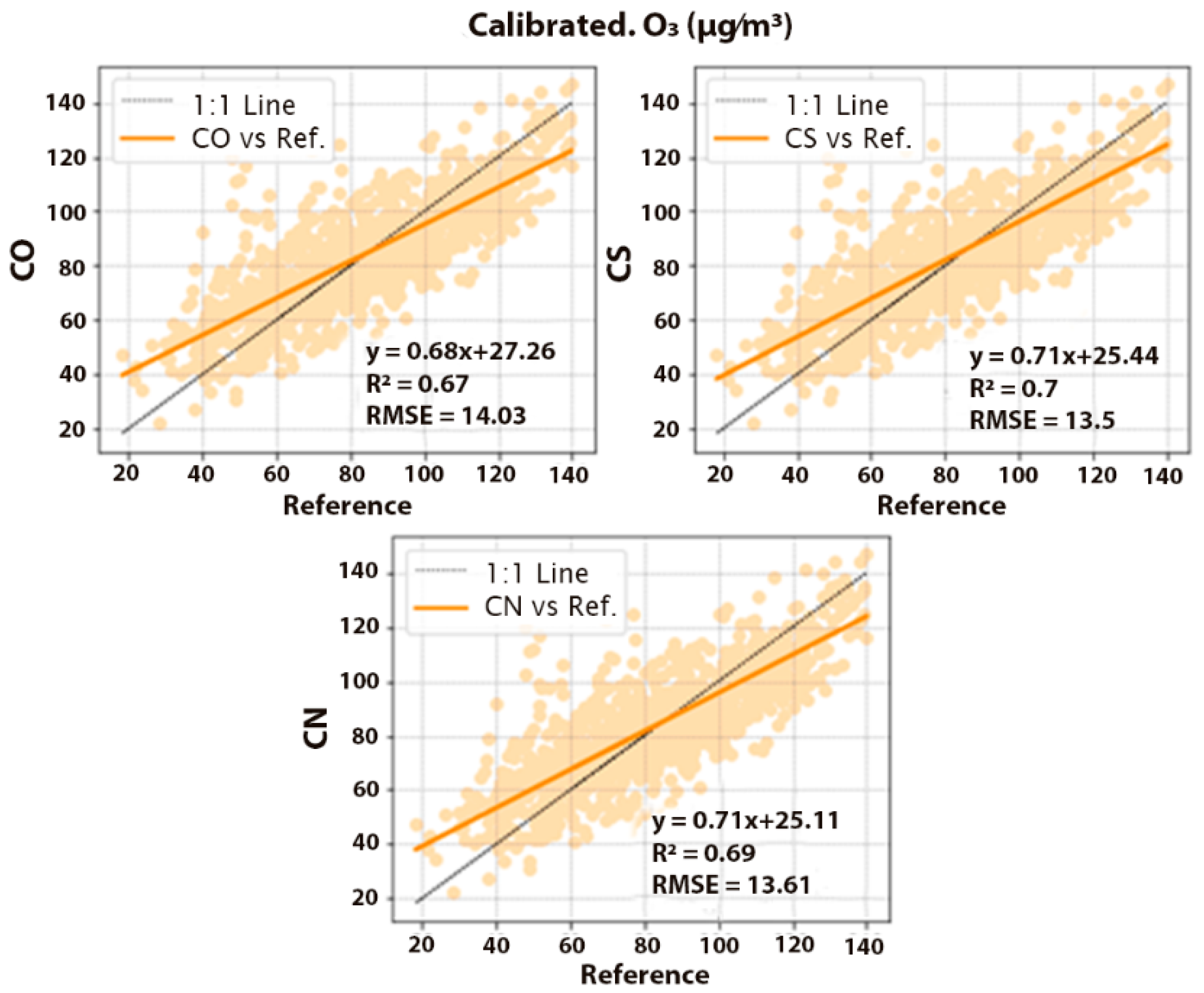
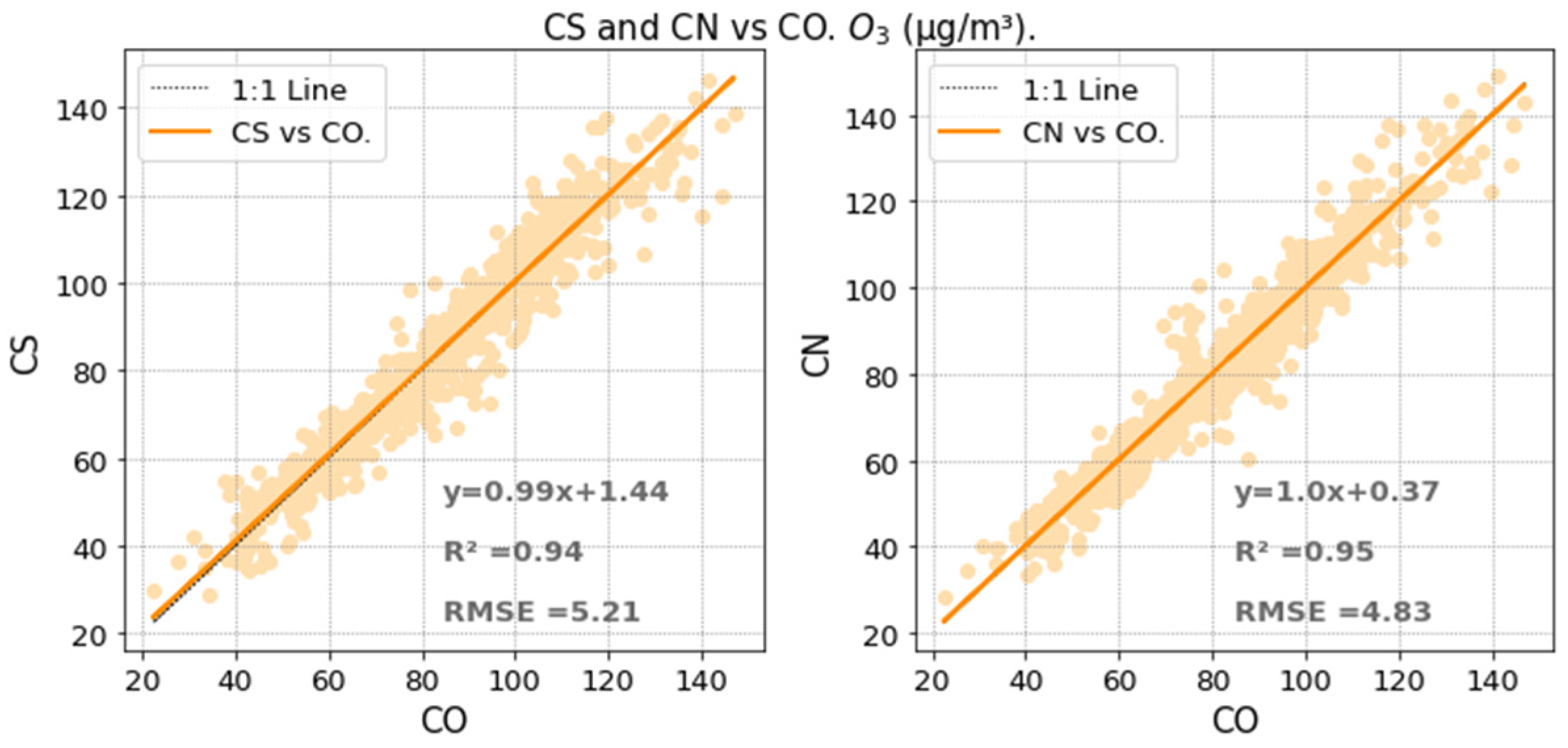
| # | Model | Pollutant | Range (pbb) | Power (mW) |
|---|---|---|---|---|
| CO1 | MiCS 2714 (OX) | NO2 | 50–104 | 43 |
| CO2 | MiCS 4514 (OX) | NO2 | 50–104 | 43 |
| CO3 | MiCS 4514 (RED) | CO | 103–106 | 76 |
| CO4 | MiCS 6814 (OX) | NO2 | 50–104 | 43 |
| CO5 | MiCS 6814 (RED) | CO | 103–106 | 76 |
| CO6 | MiCS 6814 (OX) | NO2 | 50–104 | 43 |
| CO7 | MiCS 6814 (RED) | CO | 103–106 | 76 |
| CO8 | FIS SP3-61 | O3 | 2–103 | 400 |
| ZnO:Ga Thin-Film | SnO2:G Nanofibrous Layer | ||||
|---|---|---|---|---|---|
| # | Film Thicknes (nm) | Power (mW) | # | Graphene Type | Power (mW) |
| CN1 | 25 | 25 | CS1 | RGO | 41 |
| CN2 | 25 | 5–25 | CS2 | RGO | 41 |
| CN3 | 50 | 25 | CS3 | PG | 14.5 |
| CN4 | 50 | 5–25 | CS4 | PG | 41 |
| CN5 | 50 | 25 | CS5 | GNPL | 14.5 |
| CN6 | 50 | 5–25 | CS6 | GNPL | 41 |
| - | - | - | CS7 | − | 14.5 |
| - | - | - | CS8 | − | 14.5 |
| CO | CS | CN | |||
|---|---|---|---|---|---|
| Value | Value | %CO | Value | %CO | |
| R2 | 0.67 | 0.70 | 104.5 | 0.69 | 103.0 |
| RMSE (µg m−3) | 14.03 | 13.50 | 96.2 | 13.61 | 97.0 |
| Slope | 0.68 | 0.71 | 104.4 | 0.71 | 104.4 |
| Intercept (µg m−3) | 27.26 | 25.44 | 93.3 | 25.11 | 92.1 |
| CO | Value | Standard Error | Lower (95%) | Upper (95%) |
| Intercept | 17.62 | 1.28 | 15.11 | 20.14 |
| Slope | 0.80 | 0.02 | 0.77 | 0.83 |
| Relative expanded uncertainty (k = 2) (%) | 20.41 | |||
| CN | Value | Standard Error | Lower (95%) | Upper (95%) |
| Intercept | 15.54 | 1.24 | 13.12 | 17.97 |
| Slope | 0.82 | 0.01 | 0.79 | 0.85 |
| Relative expanded uncertainty (k = 2) (%) | 19.39 | |||
| CS | Value | Standard Error | Lower (95%) | Upper (95%) |
| Intercept | 16.16 | 1.17 | 13.86 | 18.46 |
| Slope | 0.82 | 0.01 | 0.79 | 0.85 |
| Relative expanded uncertainty (k = 2) (%) | 19.45 | |||
Publisher’s Note: MDPI stays neutral with regard to jurisdictional claims in published maps and institutional affiliations. |
© 2022 by the authors. Licensee MDPI, Basel, Switzerland. This article is an open access article distributed under the terms and conditions of the Creative Commons Attribution (CC BY) license (https://creativecommons.org/licenses/by/4.0/).
Share and Cite
Gómez-Suárez, J.; Arroyo, P.; Cerrato-Álvarez, M.; Hontañón, E.; Masa, S.; Menini, P.; Presmanes, L.; Alfonso, R.; Pinilla-Gil, E.; Lozano, J. Development and Field Validation of Low-Cost Metal Oxide Nanosensors for Tropospheric Ozone Monitoring in Rural Areas. Chemosensors 2022, 10, 478. https://doi.org/10.3390/chemosensors10110478
Gómez-Suárez J, Arroyo P, Cerrato-Álvarez M, Hontañón E, Masa S, Menini P, Presmanes L, Alfonso R, Pinilla-Gil E, Lozano J. Development and Field Validation of Low-Cost Metal Oxide Nanosensors for Tropospheric Ozone Monitoring in Rural Areas. Chemosensors. 2022; 10(11):478. https://doi.org/10.3390/chemosensors10110478
Chicago/Turabian StyleGómez-Suárez, Jaime, Patricia Arroyo, María Cerrato-Álvarez, Esther Hontañón, Sergio Masa, Philippe Menini, Lionel Presmanes, Raimundo Alfonso, Eduardo Pinilla-Gil, and Jesús Lozano. 2022. "Development and Field Validation of Low-Cost Metal Oxide Nanosensors for Tropospheric Ozone Monitoring in Rural Areas" Chemosensors 10, no. 11: 478. https://doi.org/10.3390/chemosensors10110478
APA StyleGómez-Suárez, J., Arroyo, P., Cerrato-Álvarez, M., Hontañón, E., Masa, S., Menini, P., Presmanes, L., Alfonso, R., Pinilla-Gil, E., & Lozano, J. (2022). Development and Field Validation of Low-Cost Metal Oxide Nanosensors for Tropospheric Ozone Monitoring in Rural Areas. Chemosensors, 10(11), 478. https://doi.org/10.3390/chemosensors10110478










